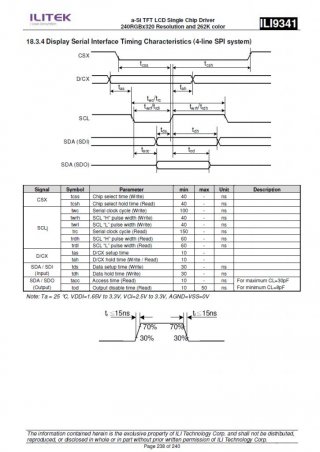On a current project we need a reliable source for a small color touchscreen to be used for maintenance and service purposes. Plug it in to see what the system is really doing. The public user interface is a 2x16 character LCD, so very limited, and we don't want to display diagnostic details on it. We did a custom board for one thing to work with a 24" cable from the main board (which is relatively inaccessible, so our design uses 74VHC125 buffers and the signals look good on a scope.) Our board will accomodate either the resistive or capacitive touch versions of the display.
We need initially a few hundred a year, possibly a few thousand if this idea gets used on a future project. Since the PJRC and eBay ILI9341 displays we tested have good screen quality and are inexpensive and reliable, and there is already a good support library from Adafruit (we bought displays from them too) and PJRC (ILI9341_t3) that seemed like a logical starting point. However the eBay displays are poorly packaged (recent order had 4/5 received with cracked screens) and gray-market vendors on eBay are never a reliable source for anything. Some searching led us to BuyDisplay and they appear to be a legitimate, good quality vendor. Their order arrived packaged very professionally. Other vendors include DisplayTech (DT028ATFT-TS) which also uses the ILI9341. Sadly there seem to be no standards for pinouts or tail length, so you can't easily make a board which works with a variety of vendors.
So I'm debugging a BuyDisplay ER-TFT028-4 2.8" color touchscreen with ILI9341 controller. But it does not act the same as the PJRC and eBay 2.8" touchscreens with ILI9341.
I am using ILI9341_t3, XPT2046_Touchscreen and SPI libraries with a Teensy 3.2 (48 MHz, Fast) and custom board. The BuyDisplay res touch does not have the XPT2046 built in so we have one on our board actually the ADS7843 which is supposed top be identical but may not be).
I am also testing one of the eBay ILI9341 displays with short test leads from our board header, just as a sanity check, and it works properly. So I expect the BuyDisplay to act the same... but no. It sometimes doesn't start up - blank white screen. Other times it will if I give it a pushbutton reset (how can this be different from the TyQt Teensy reset?).
My code drives a reset signal to the display (now mapped into the ILI9341_t3 constructor), and that signal looks good on a 'scope. All the signals look good on the BuyDisplay end of our buffered cable.
Slowing SPI SCK to 16 MHz (see this thread about that) makes the BuyDisplay much better behaved. I can't see the actual display driver chip on it, so it could be a different/slower version of the ILI9341.
Does anyone else have any experience with the BuyDisplay ILI9341 displays?
We need initially a few hundred a year, possibly a few thousand if this idea gets used on a future project. Since the PJRC and eBay ILI9341 displays we tested have good screen quality and are inexpensive and reliable, and there is already a good support library from Adafruit (we bought displays from them too) and PJRC (ILI9341_t3) that seemed like a logical starting point. However the eBay displays are poorly packaged (recent order had 4/5 received with cracked screens) and gray-market vendors on eBay are never a reliable source for anything. Some searching led us to BuyDisplay and they appear to be a legitimate, good quality vendor. Their order arrived packaged very professionally. Other vendors include DisplayTech (DT028ATFT-TS) which also uses the ILI9341. Sadly there seem to be no standards for pinouts or tail length, so you can't easily make a board which works with a variety of vendors.
So I'm debugging a BuyDisplay ER-TFT028-4 2.8" color touchscreen with ILI9341 controller. But it does not act the same as the PJRC and eBay 2.8" touchscreens with ILI9341.
I am using ILI9341_t3, XPT2046_Touchscreen and SPI libraries with a Teensy 3.2 (48 MHz, Fast) and custom board. The BuyDisplay res touch does not have the XPT2046 built in so we have one on our board actually the ADS7843 which is supposed top be identical but may not be).
I am also testing one of the eBay ILI9341 displays with short test leads from our board header, just as a sanity check, and it works properly. So I expect the BuyDisplay to act the same... but no. It sometimes doesn't start up - blank white screen. Other times it will if I give it a pushbutton reset (how can this be different from the TyQt Teensy reset?).
My code drives a reset signal to the display (now mapped into the ILI9341_t3 constructor), and that signal looks good on a 'scope. All the signals look good on the BuyDisplay end of our buffered cable.
Slowing SPI SCK to 16 MHz (see this thread about that) makes the BuyDisplay much better behaved. I can't see the actual display driver chip on it, so it could be a different/slower version of the ILI9341.
Does anyone else have any experience with the BuyDisplay ILI9341 displays?
Last edited:


